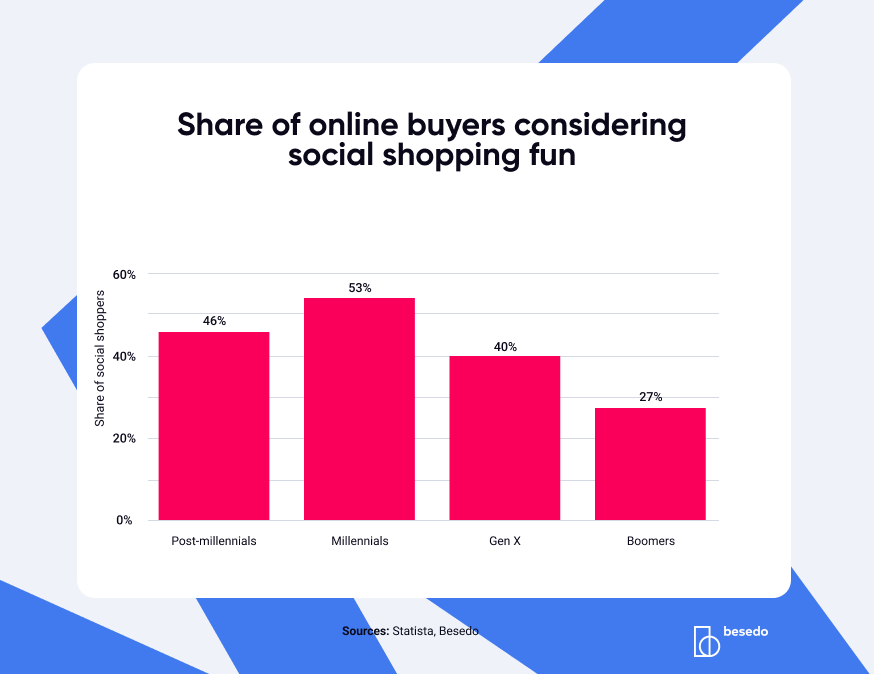Contents
We can’t deny the success of dot-coms like eBay, but it’s clear that retail is headed in a much more social direction. With platforms such as Depop and Etsy, buying items online has become both familiar AND fun! It looks like millennials are on to something — not only do they know what they want (ahem… sustainability and social interactions), but companies have taken note too, with The Guardian referring to this demographic as “mark[ing] out the future direction of retail.”
Move over, Boomer; Gen Zers are taking charge of shopping habits.

An introduction
Alright, hold up. First of all, what is social shopping?
Social shopping refers to the trend of shopping that combines social media and e-commerce. It allows consumers to discover and purchase products through social media platforms, such as Instagram, TikTok, and Facebook, as well as through influencer marketing.
In short, it means people can see and buy products directly from their favorite social media influencer or brand’s account without leaving the app.
This form of shopping provides a more personalized and engaging shopping experience, as consumers can see how products look and function in real life and get recommendations from friends and influencers they follow and trust.
A question of freedom and trust
Social shopping platforms need to find a balance between growth and sustainability. They also need to understand that their revenue is not just from selling products but also from the content created by their users to represent these products. This type of revenue model is unique to the internet and social media.
To succeed, these businesses need users to create and share interesting content. They also need to ensure that shoppers trust the products they see and the prices they pay and have support if something goes wrong, just like any other retail store, online or in-person.
The UGC revenue model
The UGC-powered revenue model is a business model that relies on user-generated content to drive revenue. In the case of social shopping platforms, the user-generated content includes images, videos, and descriptions of the products being sold. This content can increase the appeal and credibility of the products sold, providing potential customers with a more authentic and relatable view of the products.
Additionally, user-generated content can help build a community around the products and the platform itself, leading to increased engagement, customer loyalty, and revenue.
The question, then, is how these businesses can become truly sustainable – not only by reducing their users’ carbon footprints but finding the growth they need to thrive in the long term and continuing to demonstrate positive social impact.
One key to doing that successfully will be to fully understand that for these businesses, revenue is driven not just by the quality of the physical products people are trading but by the quality of the user-generated content (UGC) that people create to represent them.
All of this means that the highest of business standards will be required of something which is, by its nature, difficult to control. Much of the commercial power of UGC lies in the fact that it forms a personal connection, and – just as when we talk to people socially – the results can be surprising, joyful, and at times anarchic.

Sustainable growth for long-term success
For sustainable growth, social shopping platforms need to find a balance between user-generated content and the reliability that retail requires. This requires a proactive approach to focus on the quality of user-generated content, which is important for brand loyalty and revenue. Different platforms will have different definitions of high-quality content based on their target audience and offerings.
Good content is crucial for these businesses to succeed and should be seen as their core capability. Poor content can harm the business and brand reputation, so taking a preventative approach to content moderation is important.
It’s not a challenge that’s unique to marketplaces. Other sectors, like online dating, are based on UGC, while others, such as gaming, are increasingly reliant on it. Just as the future of shopping is more social, opportunities to find value in UGC are arising across industries. The implications for finance in these businesses will be a learning process: just as they now look at pipelines, funnels, and run rates, they may soon be tracking content health.
Conclusion and key takeaways
Gen Z is a tech-savvy social butterfly that’s always on the go! With their smartphones at the ready, they shop easily and seek advice from anyone and everyone before making a purchase. It’s no surprise that technology and social media have completely changed how they shop. Businesses better get their act together if they want sustained growth.
To win over this generation, you must bring your A-game in content creation and build trust with consumers. Are you ready to join the social shopping revolution?
Ahem… tap, tap… is this thing on? 🎙️
We’re Besedo and we provide content moderation tools and services to companies all over the world. Often behind the scenes.
Want to learn more? Check out our homepage and use cases.
And above all, don’t hesitate to contact us if you have questions or want a demo.




